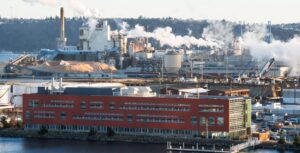
Climate Action
Human activities are rapidly increasing greenhouse gas levels in the atmosphere, trapping heat and driving climate change. These changes impact us globally, nationally, and right here in Tacoma. Our city’s natural ecosystems, infrastructure, and the health of our communities are at risk.
What Does Climate Change Mean for Tacoma?
Tacoma faces several vulnerabilities due to climate change, including:
- Rising summer temperatures, particularly in urban areas
- Increased wildfire smoke affecting air quality and health
- Rising sea levels leading to flooding, coastal erosion, and habitat loss in tidal flats
- Reduced snowpack, which impacts freshwater availability, winter recreation, and salmon populations
- Changing stream flow and temperature from faster snowmelt and altered rain patterns
- Heavier rainstorms and more frequent extreme weather
The City of Tacoma is actively working to mitigate climate change with aggressive carbon reduction targets and progress tracking on key environmental actions. Learn more about our efforts below.
Climate Resolutions and Inititiatives
-
In December 2019, City Council approved Resolution No. 40509, declaring a climate emergency in Tacoma, and affirming Council’s support of initiatives that mitigate impacts. Read more.
-
The City of Tacoma developed the 2030 Climate Action Plan in 2021. In 2025 an update was adopted that lays out new priority actions. Read more.
-
This strategy was developed in 2021 to understand Tacoma’s climate vulnerabilities, and to help the City continue to invest in a climate-resilient and climate-smart future by building on our long history of climate action. Read more.
-
An inventory of our City and community greenhouse gas emissions is conducted every few years to monitor the sources of our emissions and to better understand the effectiveness of the actions we are taking to reduce emissions. Read more.
Commitment to Decarbonization
-

A resolution to reduce the City’s carbon footprint by limiting natural gas and fossil fuel use in City buildings and future projects. It also encourages other local areas to follow suit and explores the impact of applying similar restrictions to new commercial and residential construction. Read more.
-
The Tacoma Community Building Decarbonization Strategy outlines a comprehensive, data-driven plan to phase out fossil-fuel appliances and decarbonize residential and commercial buildings by 2050 while addressing the needs of frontline communities most impacted by climate change. Read more.
-

The City of Tacoma’s Decarbonization Study, conducted in collaboration with McKinstry, offers strategic guidance on decarbonizing city facilities, provides recommendations for prioritizing projects, managing assets, and planning capital improvements to meet Tacoma’s carbon reduction goals. Read more.
Tacoma’s Climate Action Journey
Tacoma’s commitment to climate action began in 2005 when then-Mayor Bill Baarsma signed the U.S. Mayors Climate Protection Agreement, signaling the City’s dedication to reducing greenhouse gas emissions. Over the years, this commitment has evolved into comprehensive strategies and initiatives. The formation of the Green Ribbon Task Force in 2007 led to the creation of Tacoma’s first Climate Action Plan (CAP) in 2008, which laid the groundwork for the City’s ongoing environmental efforts. Building on this foundation, the City has continued to develop and implement robust plans, including the 2016 Environmental Action Plan and the 2030 Climate Action Plan. Today, Tacoma remains focused on achieving carbon neutrality, enhancing environmental justice, and ensuring a sustainable and resilient future for all its residents.
Past Climate Action and Progress
-
Tacoma’s commitment to reducing greenhouse gas emissions began in 2005 when Mayor Bill Baarsma signed the U.S. Mayors Climate Protection Agreement. In 2007, the Tacoma City Council established the Green Ribbon Task Force on Climate Change to develop strategies for aligning the city’s efforts with the Kyoto Protocol’s reduction goals. The Task Force, consisting of 25 diverse community representatives, was tasked with creating the City of Tacoma Climate Action Plan (CAP).
Over a year, the Task Force reviewed various climate action plans and engaged the community through public meetings and an online survey, gathering input to shape their recommendations. In May 2008, they proposed over 40 new climate strategies, which became the foundation of the 2008 CAP, unanimously adopted by the City Council in July of that same year. Key outcomes included the creation of the Office of Sustainability and the Sustainable Tacoma Commission in 2009. The CAP has remained a priority for the City Council and serves as a cornerstone for Tacoma’s ongoing sustainability efforts.
-
The 2008 Climate Action Plan (CAP) was Tacoma’s first step in establishing carbon reduction goals and strategies. The Plan’s top recommendations led to the creation of the Office of Sustainability and the Sustainable Tacoma Commission, both of which were established in the spring of 2009 to drive the City’s sustainability efforts.
-
In April 2016, the Tacoma City Council adopted Resolution 39427 pledging to provide guidance and investments to meet the target goals for the Plan. This support will help Tacoma respond to climate change and make Tacoma a safer, healthier, and more equitable city for its residents. The 2016 Environmental Action Plan EAP sets the path for both the City of Tacoma and the community to take meaningful action in reducing greenhouse gas emissions. It supports the climate goals established in the 2008 Climate Action Plan and outlines high-priority actions for the City and community to achieve between 2016 and 2020, in alignment with the environmental objectives in the Tacoma 2025 Strategic Plan.